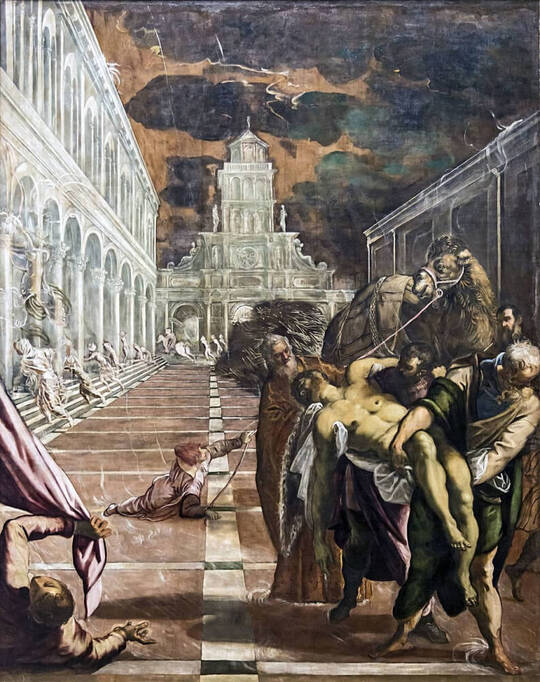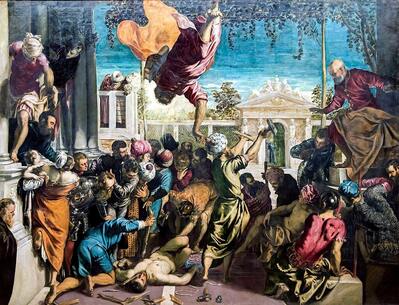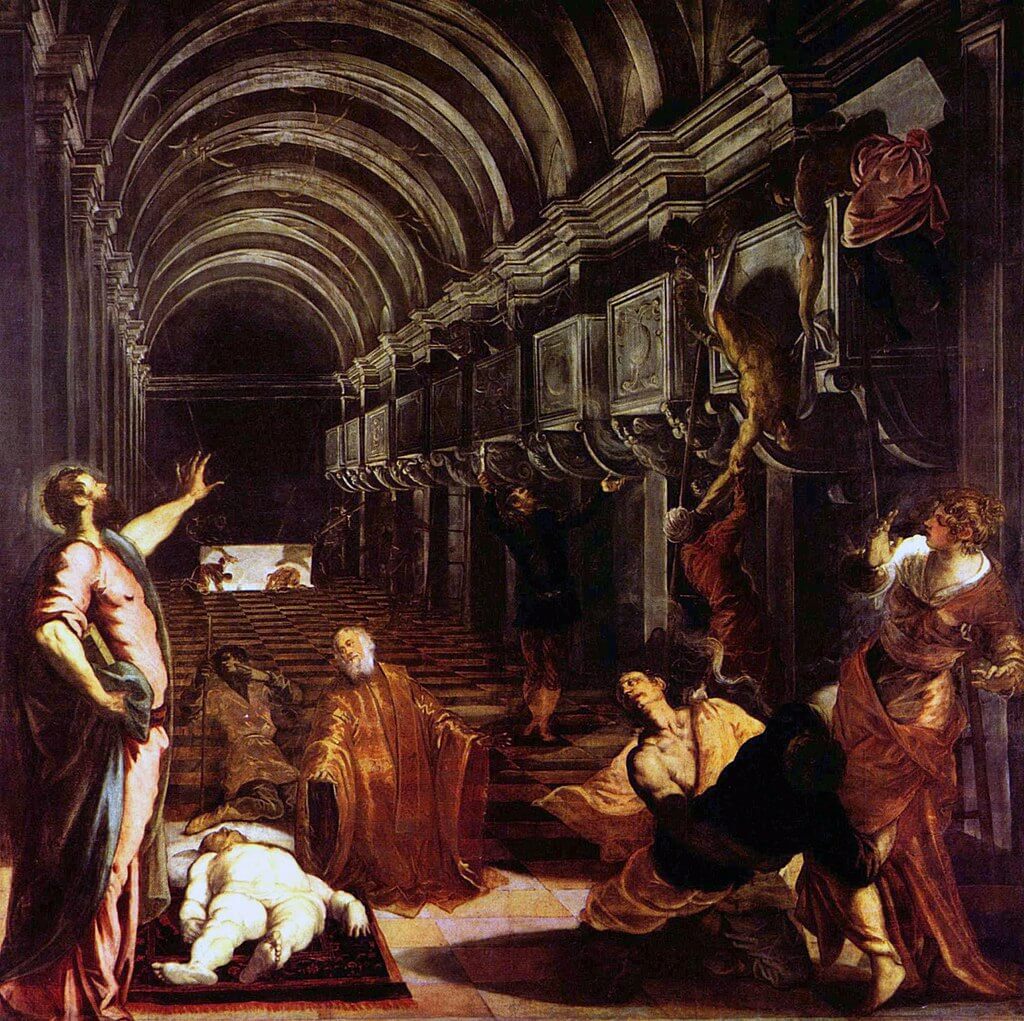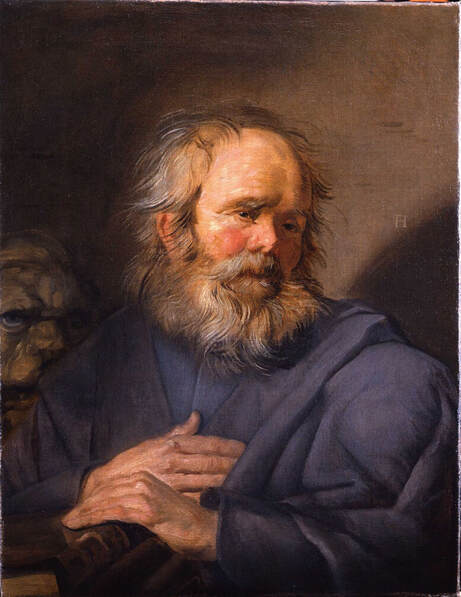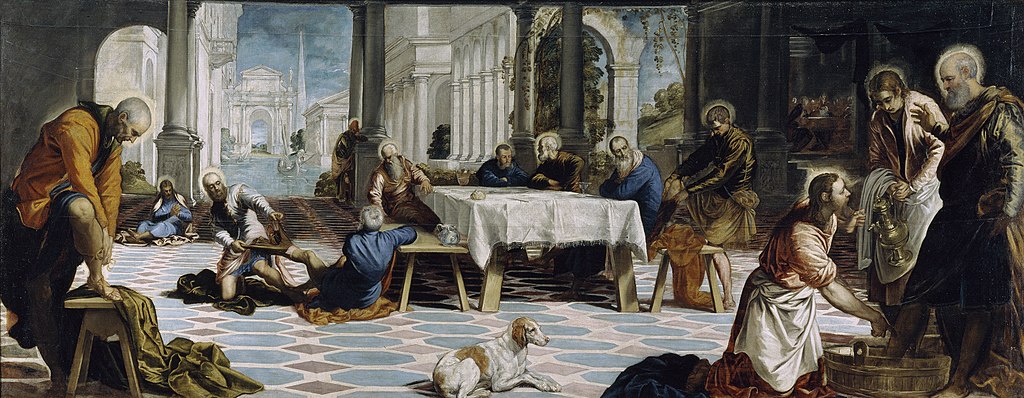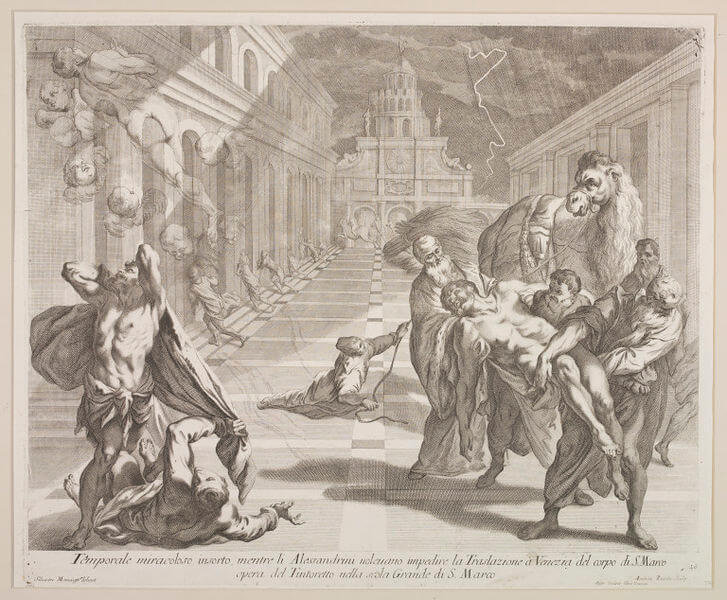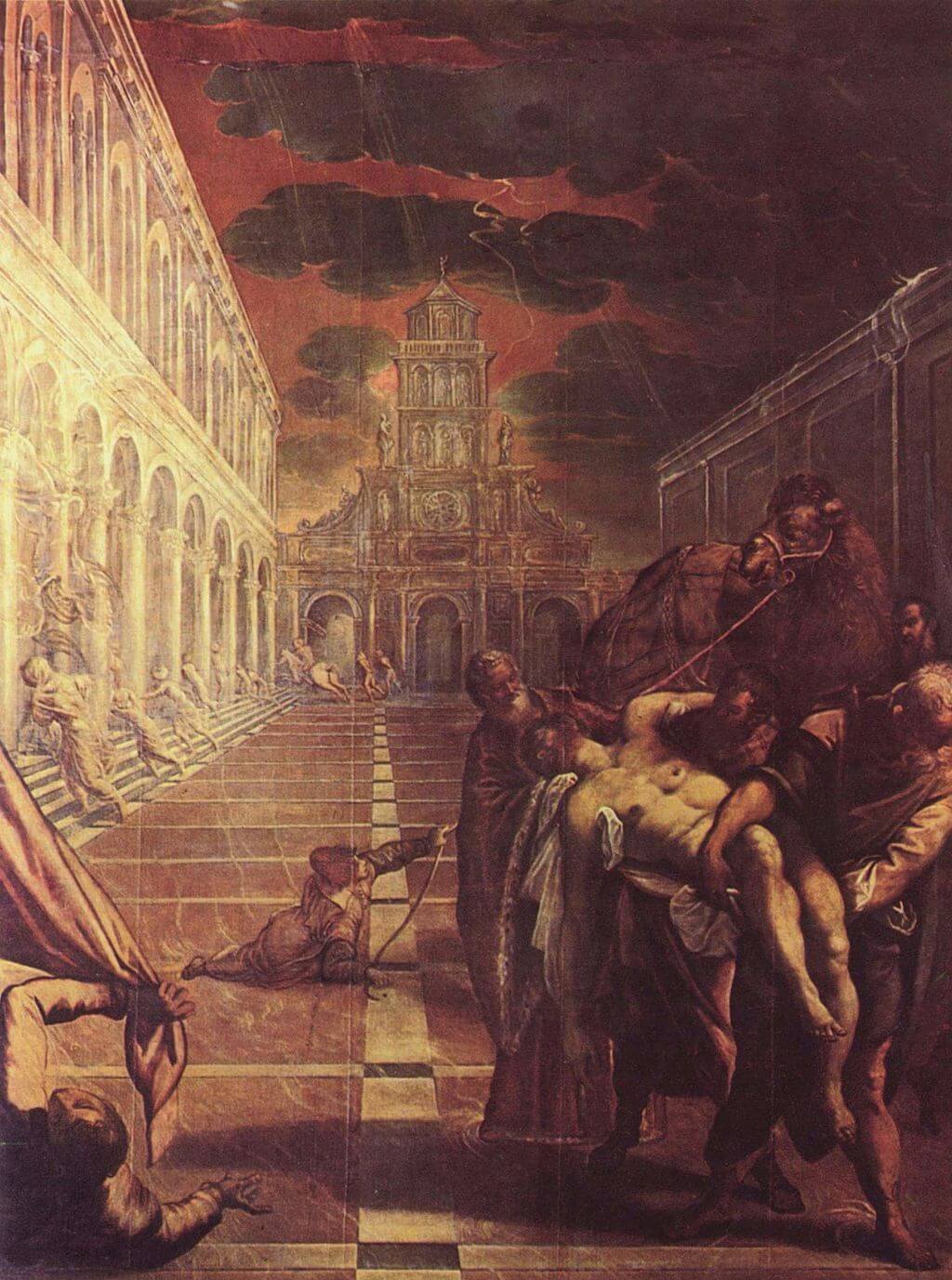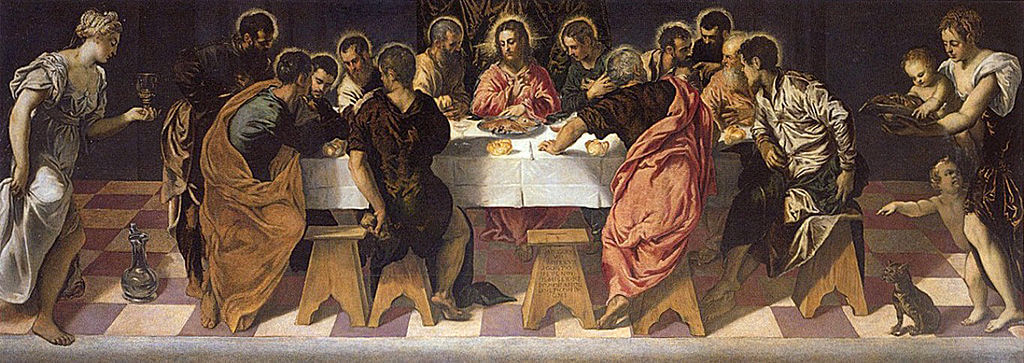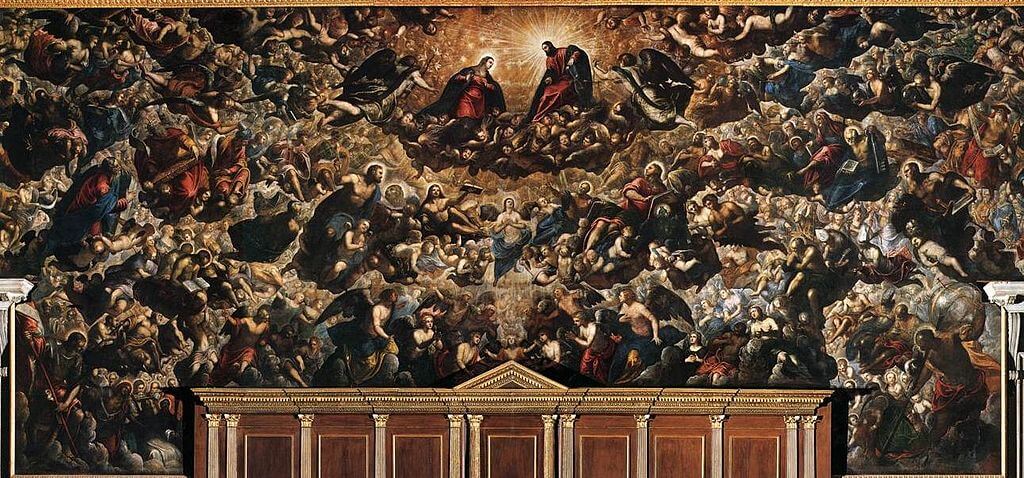|
Where? Room 10 of the Gallerie dell’Accademia
When? 1562-1566 Commissioned by? Tomasso Rangone, a Venetian patron of the arts and the Guardian Grande of a large confraternity in Venice. What do you see? Three people carry the dead body of Saint Mark. The person in the brown robe, holding the head of Saint Mark, is the commissioner of this painting, Tomasso Rangone. The bearded man to the right of dromedary is Tintoretto. In the background is a woodpile on which the body of Saint Mark was supposed to be burned and from which the Christians in this painting stole Saint Mark’s body. The sky in the background is red and dark and contains a lightning strike. The sky refers to the hailstorm that came down at the moment that the killers of Saint Mark wanted to burn him on the pyre. In the left foreground lays a man pulling a cloth. In the original painting, this man was fighting with another man over this a protective cloth of Saint Mark. However, this part of the painting has been cut off. Behind the scene on the body of Saint Mark, there is a dromedary that escaped from his owner who lays on the ground holding on to the leash. It may be a symbolical reference to the death of Saint Mark as a martyr, but this is not entirely clear. Perspective: Tintoretto used linear perspective in this painting which becomes clear when looking at the buildings and the white limestone on the floor. He matched the colors in this painting to emphasize this perspective. The colors in the foreground are darker than those in the background. He painted the people in the foreground in dark colors and the smaller people in the background, who are running away from the thunderstorm, are completely white. Series of Paintings on Saint Mark: This work was commissioned as part of a series of paintings on Saint Mark. The theme of Saint Mark was chosen as Saint Mark is the patron saint of Venice. Tintoretto completed four paintings for the Chapter Room of the Scuola Grande di San Marco. The other three paintings are Miracle of the Slave and Saint Mark Saving a Saracen from Shipwreck in the Gallerie dell’Accademia and the Finding of the Body of St Mark in the Pinacoteca di Brera in Milan.
Backstory: This painting was commissioned for the Scuola Grande di San Marco, a confraternity in Venice. It is known under a variety of names, including: “Saving of the Body of St Mark,” “The Abduction of the Body of St Mark,” “St Mark’s Body Brought to Venice,” and “Transport of the Body of St. Mark.” The last two names incorrectly label this painting as one that deals with the transport of Saint Mark’s body to Venice.
Saint Mark was killed in Alexandria, Egypt, in 68 AD. He was killed in a horrific way. His killers put a rope around his neck and dragged him through the streets until he was dead. The plan was to burn his body. However, right after he was killed and was put on the pyre, there was a hailstorm which caused his killers to flee, and therefore his body could be recovered by fellow Christians. They buried him with great respect in the Church of Alexandria. Interestingly, the scene in this painting is supposed to take place in Alexandria, Egypt. However, the architecture in this painting is quite similar to the Piazza San Marco in 16th-century Venice. Who is Saint Mark? The supposed writer of the Gospel of Mark. He is also the founder of the Church of Alexandria, which was one of the most important churches in Early Christianity. His symbol is a lion, which is illustrated in the painting Saint Mark by Frans Hals in the Pushkin Museum in Moscow. In 828 AD, two Venetian merchants stole his body from Alexandria and transported it to Venice. The Doge of Venice stated in his will to build a basilica for Saint Mark where his body would be buried. This is the famous St Mark’s Basilica on the Piazza San Marco in Venice. In 1063, Saint Mark’s body could not be found anymore, but according to a legend, Saint Mark stuck out his arm from a pillar to reveal the location of his body.
Who is Tintoretto? Jacopo Comin (1518-1594), better known as Tintoretto is one of the three most celebrated painters from Venice; the other being Titian and Veronese. Just like the other Venetian painters, he used beautiful colors in his paintings. The figures he painted were inspired by the Mannerist style as used by Michelangelo.
Tintoretto often painted a group of people in an impressive architectural setting inspired by 16th-century Venice. He also enjoyed developing innovative perspectives. Another example of his style is The Washing of the Feet in the Prado Museum in Madrid.
Fun fact: Until around 1815, the painting was in its original location, the Scuola Grande di San Marco in Venice. Then, Napoleon confiscated it, and pieces from the left and the right of the painting were cut, and two pieces were added to the bottom and the top.
The first picture below shows how the painting looked like originally. You can see that the original painting, for example, contained an image of the transparent body of Saint Mark ascending to Heaven. Several angels support him. On the left side of the current version of the painting, we can still see the feet of Saint Mark’s soul and parts of two angels. The second picture below shows the result after the changes to the painting in the 19th century. In addition to changing the dimensions of the painting, the woodpile was also removed from the painting. Without the woodpile, the painting could be interpreted as the transfer of the body of Saint Mark in 828 from Alexandria to Venice. In 1959, the painting was restored, and the pyre was added back. The pieces that were cut off on the left and right, however, could not be restored. Interested in a copy for yourself? Poster or canvas
0 Comments
Where? Room 25 of the Prado Museum
When? 1548-1549 Commissioned by? The Church of San Marcuola in Venice What do you see? On the right, Jesus sits on his knees and washes the feet of his disciple, Peter, who is reluctantly accepting that his master washes his feet. The young disciple, John, helps them by holding a watering can to fill the tub. In line with the Biblical story, Jesus has a towel wrapped around his waist. He has taken off his blue robe, which lies behind him. Scattered around the area are the other disciples. Four of them sit on the table. To the left of the table, one disciple comically helps another one to take of his pants. The disciple in the left foreground and the one to the right of table take off their sandals to have their feet washed. The disciple standing in the background against a pillar is Judas, who is about to betray Jesus after the Last Supper. Behind the head of Jesus, we can see another room with the follow-up scene. In that room are Jesus and his disciples celebrating the Last Supper. In the background, we can see some made-up architecture, based on 16th-century Venice. There is a canal with at the end a triumphal arch. Perspective: To fully appreciate this painting, one should look at it from the right side. So, stand to the right of the painting and you will see that the perspective suddenly is correct and that this is a beautiful piece of work. The composition starts with Jesus and Saint Peter, continues through the middle of the table, and ends at the arch at the end of the water. Notice how the tiles on the floor suddenly have a straight pattern. The reason that one should look at it from the right is that Tintoretto created this painting originally to hang on the right side of the apse (the area where the altar stand) in a Venetian church. Therefore, the churchgoers would automatically look at this painting from the right side. Backstory: This painting is also known as Christ Washing the Disciples' Feet. It is based on the Biblical story in John 13: 1-20, in which Jesus washes the feet of his disciples before they eat the Last Supper. Washing the feet was a common thing before having dinner as the people at that time wore sandals and walked on dusty roads. Typically, a servant washed the feet of the guests before dinner. Tintoretto created this painting for the Church of San Marcuola in Venice. On the left side of the apse hangs the Last Supper by Tintoretto and on the right side hung this painting on Christ washing the feet of the disciples. Today, it is replaced by a copy by Carlo Ridolfi (who also wrote a biography on Tintoretto). The original by Tintoretto entered the collection of the Prado Museum in 1936.
Other versions: Tintoretto loved the theme of Christ washing the feet of his disciples, and he created at least five different versions of it. Just like he did in the San Marcuola Church in Venice, Tintoretto often combined this painting with a painting on the Last Supper.
One version of Christ Washing the Feet of the Disciples hangs now in the National Gallery in London but was originally in the San Trovaso Church in Venice. Another version is in the San Moisé Church in Venice. Yet another version, very similar to the one in the Prado Museum, hangs in the Shipley Gallery of Art in Gateshead, England. It is not completely clear whether the original version in the Church of San Marcuola is the version in the Prado Museum or the Shipley Gallery of Art. A copy by Tintoretto of the Prado version hangs in the Ontario Gallery of Art in Toronto.
Moral: Jesus shows his humility by washing the feet of his disciples. As the leader of the disciples and the Son of God, he wanted to set an example that people are equal and that you are never better than another person.
Who is Tintoretto? Jacopo Comin, better known as Tintoretto, was born in 1518 in Venice and died there in 1594. He was a very talented painter. His aim was to combine the Mannerist drawing style of Michelangelo with the use of colors by Titian. This style is exactly what characterizes his work. Tintoretto was the oldest child and had twenty siblings. Tintoretto means ‘little dyer,’ and he was known by that name as his father was a dyer of clothes. Tintoretto was a very energetic and productive painter, and he created a large number of paintings often containing many figures. His masterpiece, Paradise, hangs in the Doge’s Palace in Venice. He started this painting when he was 70 years old, it includes over 500 figures, and measures about 25 x 9 meters.
Fun fact: The paintings contains a few interesting details. First, Judas is shown in the background. He has a halo around his head. This is strange as Judas is about to betray Jesus and halos are used to identify holy or sacred people. While Tintoretto is not the only artist to put a halo around the head of Judas, he is more commonly depicted without a halo, and sometimes with a black or darker-colored halo to separate him from the other disciples.
Another interesting detail is the dog in the foreground. It is not entirely clear why the dog is there. In any case, the presence of the dog caused Tintoretto some trouble. The inquisition thought that this was an unnecessary detail in this painting and this kind of detail was strongly discouraged for religious use by the Council of Trent earlier in the 16th century. |
Categories
All
|
- Home
- Blog
-
Museums
- Alte Pinakothek
- Art Institute of Chicago
- Baltimore Museum of Art
- Barber Institute of Fine Arts
- Bargello
- Barnes Foundation
- British Museum
- Church of Sant’Anastasia
- Cleveland Museum of Art
- Courtauld Institute of Art
- Detroit Institute of Arts
- Frans Hals Museum
- Galleria Borghese
- Gallerie dell'Accademia
- Getty Museum
- Guggenheim
- Hermitage Museum
- Kunsthistorisches Museum
- Kunstmuseum Basel
- Legion of Honor Museum
- Louvre
- Mauritshuis
- Metropolitan Museum of Art
- Musee d’Orsay
- Museum of Fine Arts in Boston
- Museum of Modern Art
- National Gallery in London
- National Gallery of Art
- National Museum in Poznań
- Norton Simon Museum
- Ny Carlsberg Glyptotek
- Palace of Versailles
- Palazzo Pitti
- Palazzo Vecchio
- Petit Palais
- Philadelphia Museum of Art
- Prado
- Pushkin Museum
- Ravenna Art Museum
- Rijksmuseum
- San Diego Museum of Art
- Santa Maria delle Grazie
- St. Peter's Basilica
- Städel Museum
- Statens Museum for Kunst
- Tate Britain
- Tate Modern
- Timken Museum of Art
- Uffizi
- Vatican Museums
- Wallace Collection
-
Artists
- Altdorfer
- Anguissola
- Berlin Painter
- Bosch
- Botticelli
- Boucher
- Bronzino
- Bruegel the Elder
- Brunelleschi
- Cabanel
- Caillebotte
- Canova
- Caravaggio
- Carpeaux
- Cezanne
- Cimabue
- David
- Degas
- Delacroix
- De Maria
- Donatello
- El Greco
- Fontana
- Fra Angelico
- Fragonard
- Gauguin
- Gentileschi
- Gericault
- Gonzalez-Torres
- Goya
- Hals
- Hogarth
- Hokusai
- Ingres
- Leonardo da Vinci
- Lippi, Filippo
- Longhi, Barbara
- Lorrain
- Makovsky
- Manet
- Massys
- Matisse
- Merian
- Michelangelo
- Mochi
- Modigliani
- Monet
- Panini
- Parmigianino
- Perugino
- Picasso
- Pisanello
- Raphael
- Rembrandt
- Renoir
- Reynolds
- Rivera
- Rodin
- Rubens
- Scultori
- Seurat
- Steen
- Tintoretto
- Titian
- Toulouse-Lautrec
- Turner
- Uccello
- Van der Weyden
- Van Dyck
- Van Eyck
- Van Gogh
- Van Hemessen
- Vasari
- Velazquez
- Vermeer
- Veronese
- Vigée Le Brun
-
Locations
- Books
- About Us

